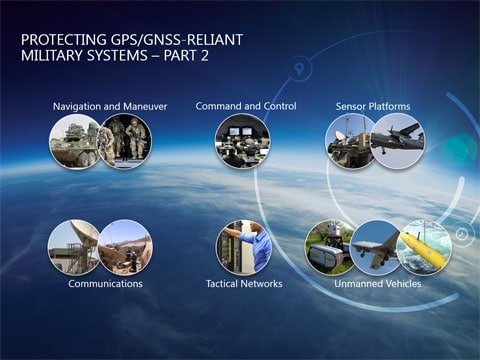Protecting GPS-Reliant Military Systems – Part 2
Now that we’ve explored where GPSGlobal Positioning System is a navigation satellite system. See also is utilized within military systems, we can imagine what would happen if warfighters faced a GPS threat or disruption.
As is widely understood, GPS signals are weak and vulnerable to interference. Interference can be unintentional, such as side band energy from radio transmissions on the battlefield, or intentional. Intentional interference can be jamming or it can be a fake signal, sometimes called spoofing or sophisticated jamming. Spoofing is potentially the most dangerous type of interference. Connectivity and signal disruption is one issue; acting on misinformation or falsified data could be catastrophic.
The Battlefield Without GPS.
The dependency on GPS is so widely rooted that it’s easy to undervalue its benefits. There are many advantages when military forces have a full digital C5ISRA military system that encompasses the technology and equipment to command, control, computers, communications, cyber-defense for intelligence, surveillance, and reconnaissance. C5ISR is designed to provide resilient situational awareness on the battlefield. (Command and Control, Communications, Computers, Cybersecurity, Intelligence, Surveillance and Reconnaissance) system. What happens when that is lost? Communications start to degrade, and secure communications might be compromised. Much of the synchronization of secure voice and data systems uses GPS. Without digital navigation, operations are back to using paper maps. Situational awareness is slower, and when warfighters lose speed they lose the tactical advantage. When digital data and digital input are gone—so are the automated systems that rely on them. In a word, it’s bad.
Layers of Defense = Assured PNTPosition, Navigation, and Timing: PNT and map data combine to create the GPS service.
GPS threats are complex – there are a variety of entry points and strategies to defend against. Military troops must operate under the assumption that GPS will fail, and be prepared for such an event. At Orolia we believe the best defense is a layered approach, what we call “Assured PNT”.
The first layer is access to multiple constellations, including GPS, Galileo, GLONASS and Beidou. An intelligent warfighter uses all the assets at their disposal. While a higher integrity PNT indication may be obtained from an agency’s own internally approved system, there are times during GPS denial that other signals may be available. Why not use them if the adversary is?
The next layer of defense for jamming is to prevent the jamming signal from reaching the receiver in the first place. Advanced antenna technologies, both passive and active, now exist. For example, CRPA (Controlled Radiation Pattern) antennas that can focus reception beams directly towards the satellites and away from the jamming source.
For data integrity, military systems have SAASM and M-Code, the encrypted military signals. These defeat spoofing. Galileo’s new Public Regulated Service (PRS) is an encrypted navigation service that has improved availability and continuity of service, as well as better resistance against spoofing and jamming.
For situations where jamming or spoofing threats are unavoidable, Orolia partnered with Talen-X to incorporate its Broadshield GNSSGlobal navigation satellite system (GNSS): A general term describing any satellite constellation that provides positioning, navigation, and timing (PNT) services on a global or regional basis. See also jam and spoof detection capabilities into Orolia’s PNT solutions. Detecting the problem is the first step toward correcting it.
The next layer is to look for alternative navigation signals. For example, ranging with either radar or by measuring the time delay of data packet transmissions, allows an estimated position based on proximity to other things and other transmitters. There are also pseudolites – pseudo satellites that are put on the battlefield to replace or substitute in for the normal GPS satellites – but they send a much stronger signal and can combat interference.
Lastly, internal, precise navigation devices can be used – an inertial measurement unit (IMUAn IMU or Inertial Measurement Unit is an electronic device that measures the heading and orientation and velocity of a vehicle. It contains both an accelerometer and a gyroscope to provide necessary data to maneuver an aircraft or spacecraft, especially when GPS signals are not available.) containing accelerometers and gyroscopes that help navigate and are nearly impossible to jam as they don’t rely on external signals. Likewise, in the timing area using internal clocks disconnects the system from external sources that can be corrupted. In fact, an atomic clock has become practical and miniaturized enough for use in mobile applications.
At Orolia, we have approached the Assured PNT requirements with flexible, configurable and scalable systems to meet the needs of each different application. But we are not stopping there. There is a whole realm of possibilities to provide Assured PNT, and we are exploring many of them for both military and commercial applications.
While GNSS-reliant military systems have vulnerabilities, there are technology solutions available today that ensure the integrity and continuity of PNT data. As these technologies continue to make their way to the battlefield, warfighters will be able to move, communicate and act with confidence for mission success.


